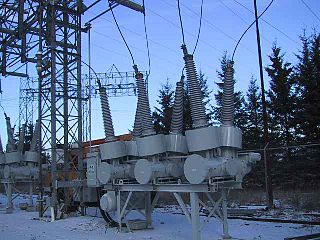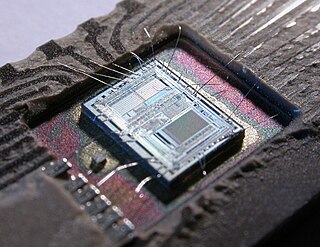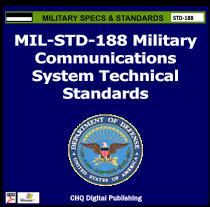In telecommunication, channel reliability (ChR) is the percentage of time a communication channel was available for use in a specified period of scheduled availability.
Mean time between failures (MTBF) is the predicted elapsed time between inherent failures of a mechanical or electronic system, during normal system operation. MTBF can be calculated as the arithmetic mean (average) time between failures of a system. The term is used for repairable systems, while mean time to failure (MTTF) denotes the expected time to failure for a non-repairable system.

A system on a chip or system on chip is an integrated circuit that integrates all components of a computer or other electronic system. These components typically include a central processing unit (CPU), memory, input/output ports and secondary storage – all on a single substrate. It may contain digital, analog, mixed-signal, and often radio frequency signal processing functions, depending on the application. As they are integrated on a single electronic substrate, SoCs consume much less power and take up much less area than multi-chip designs with equivalent functionality. Because of this, SoCs are very common in the mobile computing and edge computing markets. Systems on chip are commonly used in embedded systems and the Internet of Things.

A single-board computer (SBC) is a complete computer built on a single circuit board, with microprocessor(s), memory, input/output (I/O) and other features required of a functional computer. Single-board computers were made as demonstration or development systems, for educational systems, or for use as embedded computer controllers. Many types of home computers or portable computers integrate all their functions onto a single printed circuit board.

Components of an electrical circuit or electronic circuit can be connected in series, parallel, or series-parallel. The two simplest of these are called series and parallel and occur frequently. Components connected in series are connected along a single conductive path, so the same current flows through all of the components but voltage is dropped (lost) across each of the resistances. In a series circuit, the sum of the voltages consumed by each individual resistance is equal to the source voltage. Components connected in parallel are connected along multiple paths so that the current can split up; the same voltage is applied to each component.
Failure rate is the frequency with which an engineered system or component fails, expressed in failures per unit of time. It is often denoted by the Greek letter λ (lambda) and is highly used in reliability engineering.
Reliability engineering is a sub-discipline of systems engineering that emphasizes dependability in the lifecycle management of a product. Dependability, or reliability, describes the ability of a system or component to function under stated conditions for a specified period of time. Reliability is closely related to availability, which is typically described as the ability of a component or system to function at a specified moment or interval of time.
Reliability, availability and serviceability (RAS) is a computer hardware engineering term involving reliability engineering, high availability, and serviceability design. The phrase was originally used by International Business Machines (IBM) as a term to describe the robustness of their mainframe computers.
In computer networking, a reliable protocol is a protocol which notifies the sender whether or not the delivery of data to intended recipients was successful. Reliability is a synonym for assurance, which is the term used by the ITU and ATM Forum.
High availability (HA) is a characteristic of a system, which aims to ensure an agreed level of operational performance, usually uptime, for a higher than normal period.
Power-system protection is a branch of electrical power engineering that deals with the protection of electrical power systems from faults through the disconnection of faulted parts from the rest of the electrical network. The objective of a protection scheme is to keep the power system stable by isolating only the components that are under fault, whilst leaving as much of the network as possible still in operation. Thus, protection schemes must apply a very pragmatic and pessimistic approach to clearing system faults. The devices that are used to protect the power systems from faults are called protection devices.
The term downtime is used to refer to periods when a system is unavailable. Downtime or outage duration refers to a period of time that a system fails to provide or perform its primary function. Reliability, availability, recovery, and unavailability are related concepts. The unavailability is the proportion of a time-span that a system is unavailable or offline. This is usually a result of the system failing to function because of an unplanned event, or because of routine maintenance.
In computing, computer performance is the amount of useful work accomplished by a computer system. Outside of specific contexts, computer performance is estimated in terms of accuracy, efficiency and speed of executing computer program instructions. When it comes to high computer performance, one or more of the following factors might be involved:

A tantalum electrolytic capacitor is an electrolytic capacitor, a passive component of electronic circuits. It consists of a pellet of tantalum metal as an anode, covered by an insulating oxide layer that forms the dielectric, surrounded by liquid or solid electrolyte as a cathode. Because of its very thin and relatively high permittivity dielectric layer, the tantalum capacitor distinguishes itself from other conventional and electrolytic capacitors in having high capacitance per volume and lower weight.

Sulfur hexafluoride circuit breakers protect electrical power stations and distribution systems by interrupting electric currents, when tripped by a protective relay. Instead of oil, air, or a vacuum, a sulfur hexafluoride circuit breaker uses sulfur hexafluoride (SF6) gas to cool and quench the arc on opening a circuit. Advantages over other media include lower operating noise and no emission of hot gases, and relatively low maintenance. Developed in the 1950s and onward, SF6 circuit breakers are widely used in electrical grids at transmission voltages up to 800 kV, as generator circuit breakers, and in distribution systems at voltages up to 35 kV.
Availability is the probability that a system will work as required when required during the period of a mission. The mission could be the 18-hour span of an aircraft flight. The mission period could also be the 3 to 15-month span of a military deployment. Availability includes non-operational periods associated with reliability, maintenance, and logistics.
Maintenance Philosophy is the mix of strategies that ensure an item works as expected when needed.
Software reliability testing is a field of software testing that relates to testing a software's ability to function, given environmental conditions, for a particular amount of time. Software reliability testing helps discover many problems in the software design and functionality.
Operational availability in systems engineering is a measurement of how long a system has been available to use when compared with how long it should have been available to be used.








